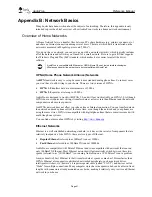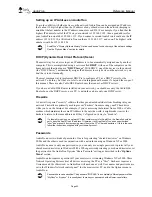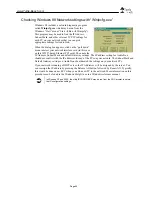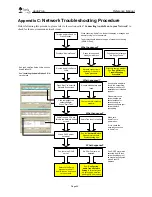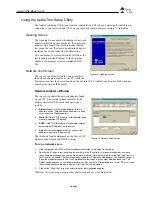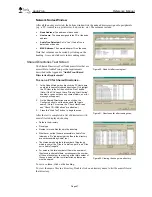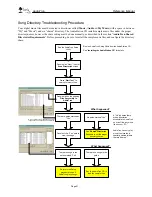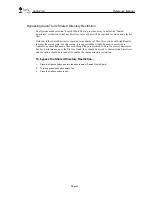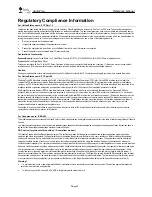
AudioTron
Reference Manual
Page 55
Regulatory Compliance Information
For United States users: FCC Part 15
This device has been tested and found to comply with the limits for a Class B digital device, pursuant to Part 15 of the FCC rules. These limits are designed to
provide reasonable protection against harmful interference in a residential installation. This equipment generates, uses, and can radiate radio frequency energy
and, if not installed and used in accordance with the instructions, may cause harmful interference to radio or television reception. However, there is no guarantee
that interference will not occur in a particular installation. If this equipment does cause interference to radio and television reception, which can be determined by
turning the equipment off and on, the user is encouraged to try to correct the interference by one or more of the following measures:
§
Re-orient or relocate the receiving antenna
§
Increase the separation between the equipment and receiver
§
Connect the equipment into an outlet on a circuit different from that to which the receiver is connected
§
Consult the dealer or an experienced radio/TV technician for help.
Declaration of conformity
Responsible party:
Voyetra Turtle Beach, Inc. 5 Odell Plaza, Yonkers, NY 10701 (914) 966-0600 Fax: (914) 966-1102 www.turtle-beach.com
Product:
AudioTron Digital Music Player
This device complies with Part 15 of the FCC Rules. Operation of this product is subject to the following two conditions: (1) this device may not cause harmful
interference, and (2) this device must accept any interference received, including interference that may cause undesired operation.
Caution
Changes or modifications not expressly approved by Voyetra Turtle Beach could void the FCC compliance and negate your authority to operate the product.
For United States users: FCC part 68
The AudioTron HPNA interface complies with Part 68 of the Federal Communications Commission (FCC) rules. On the HPNA interface card is a label that
contains the FCC registration number and Ringer Equivalence Number (REN) for this device. If requested, this information must be provided to the telephone
company. An FCC-compliant telephone line cord with a modular plug is required for use with this device. The HPNA interface is designed to be connected to the
telephone network or premises wiring using a compatible modular jack which is Part 68-compliant. See installation instructions for details.
The Ringer Equivalence Number (REN) is used to determine the number of devices which may be connected to the telephone line. Excessive RENs on a
telephone line may result in the devices not ringing in response to an incoming call. In most areas, the sum of RENs should not exceed five (5). To be certain of
the number of devices that may be connected to a line, as determined by the total RENs, contact the local telephone company. If this device causes harm to the
telephone network, the telephone company will notify you in advance that temporary discontinuance of service may be required. The telephone company may
request that you disconnect the equipment until the problem is resolved. The telephone company may make changes in its facilities, equipment, operations, or
procedures that could affect the operation of this equipment. If this happens the telephone company will provide advance notice in order for you to make
necessary modifications to maintain uninterrupted service.
Connection of the phone line interface to a party line service is subject to state tariffs. Contact the appropriate state public utility commission, public service
commission or corporation commission for information.
For Canadian users: ICES-003
This digital apparatus does not exceed the Class B limits for radio noise emissions from digital apparatus as set out in the radio interference regulations of Industry
Canada.
Le présent appareil numérique n’émet pas de bruits radioélectriques dépassant les limites applicables aux appareils numériques de Classe B prescrites dans le
règlement sur le brouillage radioélectrique édicté par Industrie Canada.
DOC notice (for products fitted with an IC-compliant modem)
The Industry Canada label identifies certified equipment. This certification means that the equipment meets certain telecommunications network protective,
operation, and safety requirements. The Department does not guarantee the equipment will operate to the users’ satisfaction. Before installing this equipment,
users should make sure that it is permissible to be connected to the facilities of the local telecommunications company. The equipment must also be installed
using an acceptable method of connection. In some cases, the inside wiring associated with a single-line individual service may be extended by means of a
certified connector assembly. The customer should be aware that compliance with the above conditions may not prevent degradation of service in some situations.
Repairs to certified equipment should be made by an authorized Canadian maintenance facility designated by the supplier. Any repairs or alterations made by the
user to this equipment, or equipment malfunctions, may give the telecommunications company cause to request the user to disconnect the equipment. Users
should make sure for their own protection that the electrical ground connections of the power utility, telephone lines, and internal metallic water pie system, if
present, are connected together. This precaution may be particularly important in rural areas. The Ringer Equivalence Number (REN) assigned to each terminal
device provides an indication of the maximum number of terminals allowed to be connected to a telephone interface. The termination on an interface may consist
of any combination of devices subject only to the requirement that the sum of the Ringer Equivalence Numbers of all the devices does not exceed five (5).
Warning!
§
To avoid electrical shock or equipment malfunction do not attempt to make electrical ground connections by yourself. Contact the appropriate inspection
authority or an electrician, as appropriate.
§
To reduce the risk of fire, use only No. 26 AWG or larger telecommunications line cord.

